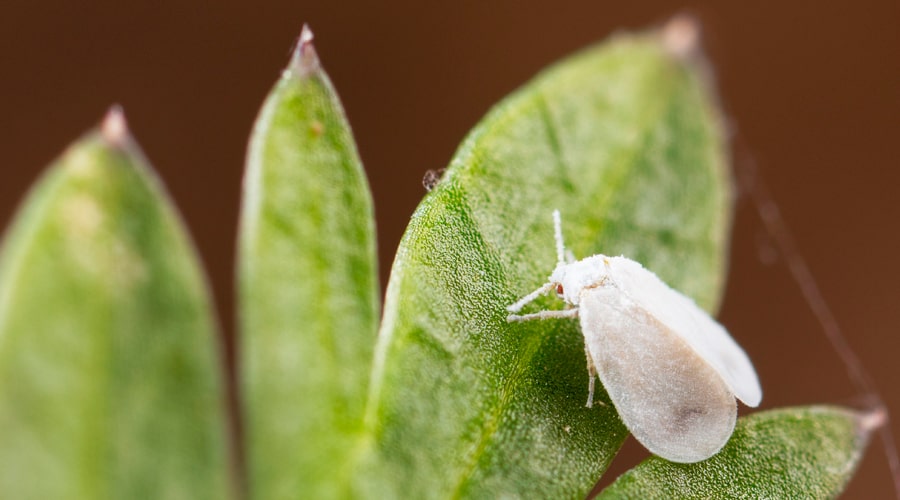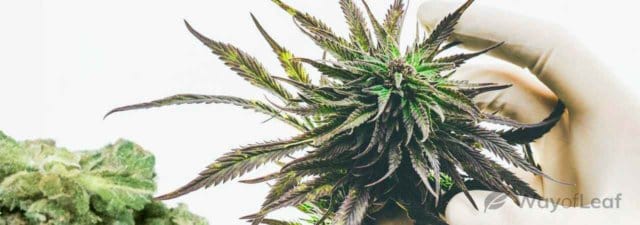Knowing how to manage common pests like the whitefly is essential for cannabis cultivators. In this short article, we will provide helpful tips about how to prevent whiteflies from infesting your crop and how to remove these pesky little pests if they do manage to infiltrate your defenses.
What Are Whiteflies?
Whiteflies are flying insects and a common pest that attacks many species of plants. They are known for having a particular love of marijuana plants, so knowing how to manage them is a must for any marijuana grower.
Whiteflies can cause significant damage to a cannabis crop by sucking sap from the plants, so early detection is key to preventing a whitefly infestation from becoming unmanageable.
How to Identify Whiteflies
Whiteflies are tiny, moth-like insects. They are around 1-2 mm in length and have a powdery white appearance. They are commonly found on the undersides of marijuana leaves, where they lay their eggs in a circular pattern.

Whiteflies undergo four nymph stages before maturing into adults. Their entire lifecycle, from egg to adult, takes about 25-30 days under optimal conditions.
Signs of a Whitefly Infestation
There are some telltale signs that your crop has been infested by whiteflies, including:
Yellow or Wilting Leaves
Whiteflies feed on the sap from marijuana plants, which removes vital nutrients and weakens them. The plant’s leaves turn yellow and begin to wilt or drop prematurely. The knock-on effect is that the plants do not photosynthesize properly, which stunts their growth.
The Presence of Sooty Mold
Whiteflies excrete a sticky substance called honeydew. Over time, as the honeydew accumulates on the plant’s leaves and stems, it can lead to the growth of sooty mold. As the sooty mold builds up on the leaves’ surface area, it directly impacts the plant’s ability to photosynthesize and grow.
Plants Showing Symptoms of Disease
Whiteflies are carriers of viruses and can transmit diseases from infected plants to healthy ones. The symptoms can be mild, such as mosaic patterns on the leaves, or severe, such as stunting the growth of the plants or causing significant crop loss.
Stressed Plants
Whitefly infestations can weaken a plant’s defenses and make it more susceptible to other pests and diseases.
How to Prevent Whiteflies from Infesting Your Crop
Preventive methods are the primary line of defense against whiteflies. These include:
- Screening: Whether you are growing marijuana indoors or in a greenhouse, it is important to place fine mesh screens on all windows and vents to keep whiteflies out.
- Companion Planting: Planting marigolds or other plants that deter whiteflies can help keep these pests away from your beloved cannabis plants.
- Reflective Mulches: An effective method of preventing whiteflies is to place reflective mulches around the base of plants to deter these pests from landing on your crop.
- Sanitation: It is essential to remove weeds and plant debris from around the marijuana plants regularly, as whiteflies may be lurking within them.
Monitor and Inspect Your Crop Regularly
You must monitor your crop regularly to detect a whitefly infestation as early as possible. You can do so by inspecting the underside of the plant’s leaves for whiteflies or their nymphs.

You can also use yellow sticky traps to monitor adult whiteflies. Careful placement of these traps near the plants can help you spot a problem early.
Introduce Some Natural Predators
An effective and environmentally friendly way to manage whiteflies is to introduce some of their natural predators to your grow site.
There are a number of predators that are proven to be effective at preventing whiteflies before they cause too much damage. These include:
- Ladybugs: Ladybugs are natural predators of whiteflies and eat both adults and nymphs.
- Lacewings: Green lacewings have a voracious appetite when it comes to eating whitefly eggs and nymphs.
- Wasps: Certain species of parasitic wasps lay their eggs in whitefly nymphs, which reduces their populations without causing harm to the marijuana plants.
Insecticides
Depending on the level of the infestation, you may have to resort to using chemicals such as insecticides.
It is critical to use the utmost care when using insecticides or pesticides to avoid harming beneficial insects or the surrounding ecosystem.
Some commonly used chemical options include:
- Insecticidal Soaps: Insecticidal soaps effectively kill whiteflies on contact without leaving toxic residues on plants. For best results, apply the soap directly to the undersides of the plant’s leaves, where whiteflies are most commonly found.
- Neem Oil: Neem oil is a natural pesticide that disrupts the lifecycle of whiteflies. It is most effective when used early, at the first sign of an infestation, and before it has become severe.
- Chemical Insecticides: In severe whitefly infestations, chemical insecticides may be necessary. It is critical to select products that are suitable for use on marijuana plants and carefully follow the application directions to avoid damaging the plants or beneficial insects.
Physical Removal
If you spot a whitefly problem before it gets out of hand, you may be able to remove the pests manually. You can do this either by gently washing the undersides of leaves with a solution of water and mild soap or by using a handheld vacuum to remove them.
Final Thoughts on How to Remove Whiteflies from Marijuana Plants
As with so many things in life, prevention is better than cure. This proverb is definitely true when it comes to whiteflies and marijuana plants.
You should do everything you can to prevent these little winged pests from landing on your plants, such as placing screens on windows and vents and planting companion plants like marigolds.
If whiteflies do make their way into your grow site, then early detection and prompt action are key to preventing an infestation from becoming severe.
![How to Clone Weed Plants [Do It the RIGHT Way!]](https://wayofleaf.com/wp-content/uploads/2018/07/mj_how-to-clone-cannabis-plants-revealed_1920-640x225.jpg)


![Mold Resistant Marijuana Strains [Top 5 Picks]](https://wayofleaf.com/wp-content/uploads/2020/04/wol-banner-mold-resistant-marijuana-strains-640x225.jpg)



![8 Tips for Growing Hindu Kush Marijuana [Grower’s Guide]](https://wayofleaf.com/wp-content/uploads/2019/01/wol_growing-hindu-kush-marijuana-640x225.jpg)
![How to Use CO2 to Increase Your Cannabis Yields [Guide]](https://wayofleaf.com/wp-content/uploads/2018/11/mj_how-to-use-co2-to-increase-marijuana-yields-explained-1-640x225.jpg)


![Why Are My Cannabis Leaves Turning Yellow? [Explained]](https://wayofleaf.com/wp-content/uploads/2020/08/wol-banner-why-are-my-cannabis-leaves-turning-yellow-640x225.jpg)
